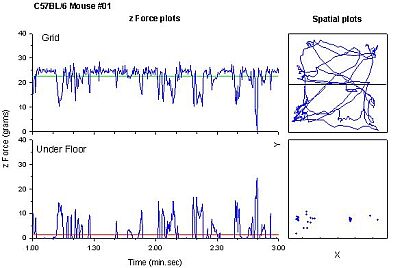
Quantifying locomotion and paw slips in a grid-actometer/ataxia-meter chamber
T.J. Zarcone and S.C. Fowler
BioBehavioral Measurement Core, University of Kansas, Life Span Institute, Lawrence, U.S.A.
A new apparatus for measuring motor performance has been developed using force transducer technology. This grid-actometer measures locomotor activity (distance travelled) and motor performance (slips from a grid) as a mouse travels around a 28 x 28 cm arena. The bottom of this arena comprises aluminium bars spaced 1 cm apart, forming a grid, with one force transducer positioned at each corner. A second surface beneath the floor, made of a honeycomb platform covered by a sheet of aluminium, is positioned 1 cm below the grid and parallel to it. Whenever a mouse slips from the grid, its paw lands on the lower floor and is detected by four more transducers, positioned at the corners of the lower floor.
All eight force sensors are serviced by a computerized data collection system, allowing on-line, real-time measurement of the forces applied at 50 Hz. In-house software permits the force data to be visualized in real-time. Data can be reviewed in their original integer form, or transformed to text for importation and processing by third party graphical or statistical programs. Initial recordings with C57BL/6 mice show that these animals slip from the grid an average of 1.6 times per metre travelled, strike the under floor with an average peak force of 13 g, and slip for an average duration of 0.25 s. Compared to an actometer comprising only the lower floor, the new grid produces changes in walking gait and significantly more excursions to the centre of the arena, thanks to a central support bar across the grid floor (Figure 1).

Figure 1. Data are shown for one C57BL/6 mouse during the 2nd and 3rd minutes of exposure to the grid-actometer chamber. Panels on the left show total (z) force against time, and panels on the right show spatial plots. Upper panels are from the grid. Lower panels are from the lower floor. The lines in the left panels show the average z force for each sample, and represent the body weight. The straight line in the top right panel represent the location of the grid support bar. The straight line in the left bottom panel at 3 g indicates the force threshold for scoring paw slips.
This measurement system may allow observations of differences between mouse strains, as well as the effects of genetic and pharmacological manipulations on locomotor activity and motor performance, with minimal experimenter handling and no explicit mouse training required. The apparatus should be useful in research areas where recovery from ataxia is used as an indication of repair to spinal damage, in studies of recovery from peripheral neuropathy, and as a general tool for phenotyping transgenic mice. Initial trials of this measurement system will be used to gather data on ethanol-treated mice.
Support: NIH22810 & NIH26930.
References
Paper presented at Measuring Behavior 2002 , 4th International Conference on Methods and Techniques in Behavioral Research, 27-30 August 2002, Amsterdam, The Netherlands